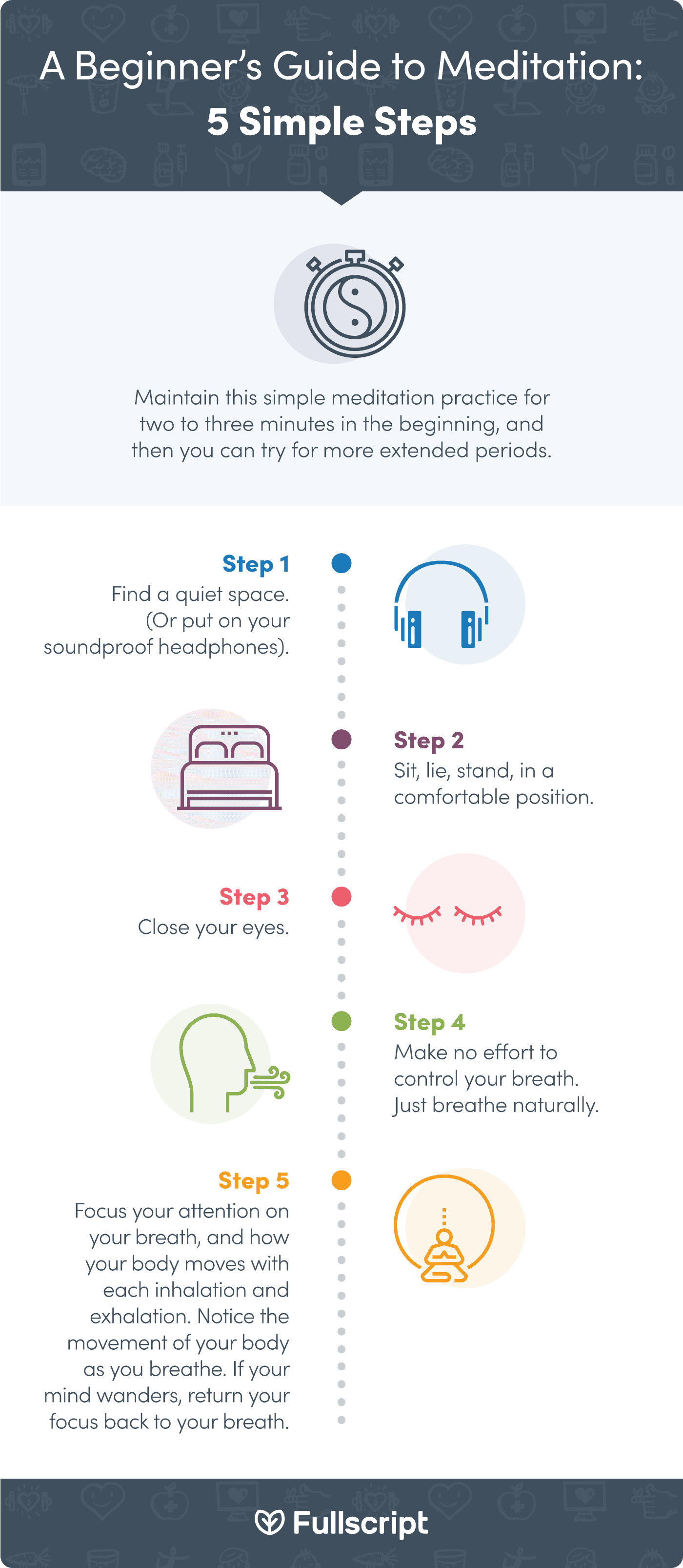Meditation – Types, Tips, Techniques
– Written by Karolina Zaremba, CNP
Meditation, a practice that originates from spiritual Buddhist and Hindu traditions, (7) includes a wide variety of contemplative exercises. (4) The term meditation often encompasses both the technique used and the altered state of consciousness that results from the practice. (4) Learn about the different types of meditation and basic meditation tips to help you develop your own practice.
Meditation can involve concentrating on internal thoughts and feelings or external objects, such as a candle flame.
What are the different types of meditation?
The various types of meditation practices generally share four key qualities:
- Being in a quiet location with minimal distractions
- Finding a comfortable position (e.g., lying down, sitting, or walking)
- Focusing attention on something (e.g., your breath, a word, or an object)
- Having an open, non-judgemental attitude (5)
Meditation can be classified in various ways, including by the techniques used, the point of focus, the spiritual or belief system the practice is derived from, and its physical effects. (1)(4)
Meditation techniques
There are a number of meditation techniques used across different meditation practices, including:
- Body scanning
- Concentrating on an object
- Concentrating on energy centers (e.g., chakras) or channeling energy through certain pathways (e.g., the spine)
- Contemplating an idea (e.g., spiritual question, contradiction, paradox)
- Cultivating feelings of loving-kindness or compassion
- Listening to sound (e.g., singing bowls)
- Manipulating breathing
- Observing something (e.g., emotions, thoughts, physical sensations)
- Repeating or singing syllables, words, or phrases
- Visualizing (e.g., body expansion, the breath combined with visuals of smoke or light)
- Walking or moving meditation (4)
Focused attention meditation practices
Focused attention (FA) techniques involve concentrating on a particular object, such as the breath, which is said to quiet the active mind. (2) FA meditation may activate brain areas associated with behavior and attention regulation, memory retrieval, and semantic processing (processing the meaning of words). (1) Examples of FA practices include breathing meditation, body awareness, mantra recitation, and candle gazing. (1)(3)
Open monitoring meditation practices
Conversely to FA meditation, open monitoring (OM) meditation does not include an object of focus. Instead, it brings attention to ‘moment to moment’ awareness. (2) OM may activate certain areas of the brain involved in the action and thought regulation, cognitive control, and sensory information processing. (1) OM approaches to meditation include acceptance and commitment therapy, mindfulness-based cognitive therapy, (3) and Vipassana meditation. (1)
Loving-kindness and compassion meditation practices
Loving-kindness meditation (LKM), sometimes referred to as compassion meditation generally uses mental images to generate compassion. LKM aims to shift emotions and thoughts and may activate brain areas associated with somatosensory (body sensation) processing, empathy, and pain perception. (1)
Meditation is accessible to anybody as it is free and doesn’t require equipment.
Types of Hindu meditation
The goal of meditation practices inspired by Hindu traditions, including several types of yoga meditation, is to reach a state of Samadhi, which translates to “unification of mind”. (7) Examples of Hindu meditation practices include:
- Kundalini yoga
- Osho meditation
- Transcendental meditation
- Yoga (4)
Types of Buddhist meditation
Buddhist meditation practices commonly have a spiritual element and try to resolve existential and ego issues. For example, individuals following the Tibetan Buddhist tradition Vajrayana practice deity meditation, which includes mantra chanting, visualization, and open monitoring. (2) There are a number of Buddhist traditions of meditation practice, including:
- Tibetan Buddhism
- Theravada
- Vipassana
- Zen (4)
Types of mindfulness meditation
Mindfulness is the act of non-judgmentally focusing on and observing the breath, body, thoughts, and/or feelings. (1) Secular (non-spiritual) mindfulness practices are generally inspired by and use some elements of Buddhist traditions. (2)
Several secular programs incorporate mindfulness meditation, such as mindfulness-based cognitive therapy (MBCT), mindfulness-based stress reduction (MBSR), and mindfulness-based relapse prevention (MBRP). (1) The focus of these programs is generally to address acute or chronic health problems, (2) and benefits have been shown in individuals with depression, anxiety, insomnia, and chronic pain. (1)
Consider incorporating daily meditation as part of a healthy lifestyle.
How to incorporate meditation into daily life
Individuals who practice meditation have reported that only a small proportion of their meditation experiences are negative. Some of the concerns with meditation are that it is challenging to learn and practice and may result in feelings or thoughts that are difficult to process. (2) The following meditation tips can support your new or existing practice.
Meditation tips for beginners
For those new to meditation, you may find it helpful to start with a FA meditation approach. Once you’ve established a practice, you can introduce OM techniques, commonly considered to be more challenging. (2) Find a quiet space in your home or outdoors where you won’t be interrupted. The meditation method you choose may specify the position in which to start, such as sitting cross-legged or lying down, but ensure you are comfortable to reduce potential distractions. If you’re thinking of trying a meditation program, seek out training with a qualified instructor. (5)
Five easy steps to follow when starting a meditation routine.
Deep meditation tips
Both FA and OM meditation are meant to develop meta-awareness, an increased awareness of our ‘self’, physical processes, and actions. (1) One study in meditators with five to 45 years of experience used an interview process designed to help meditators identify mental or physical actions during meditation and help them become aware of these processes. The study findings offer some insights into the experience of meditation and may help you to identify similar experiences in your meditation practice. (6)
The observations made by experienced meditators include:
- Feeling sensations (e.g., impulses in the chest, tightening around the throat)
- Small gestures or movements associated with emerging thoughts (e.g., tension)
- Small gestures or movements associated with vanishing thoughts (e.g., releasing tension) (6)
Mind-wandering is a normal occurrence during meditation. Any practice will involve returning attention back to the object of the meditation, such as a visualization or the breath. Finally, putting into words what you experience during meditation may help increase your awareness and clarity of what is occurring during your session. (6)
The bottom line
While there may not be one best type of meditation, various meditation practices have different merits and may resonate better with certain individuals. Whether you’re just starting to consider meditation or are an experienced meditator, the tips in this article can help optimize your practice.
If you’re looking for ways to incorporate stress relief therapies into your life, and go from chaos to calm, contact me, Dr. Linda Brown, ND at info@WoodbridgeNaturopath.com. (416) 873-5831.
Leave a Reply
Are you ready to transform your health?
Download this free ebook and watch my introductory video. Then contact me for your initial appointment or a free consult to discuss your healthcare needs.



















